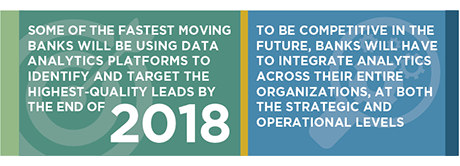
Compared to other U.S. industries, commercial banking is late entering into the age of analytics. A handful of large U.S. banks are making big investments in data analytics teams and platforms that will soon begin to deliver results. Over the long term, analytics could transform many aspects of banking and render most traditional middle-market and small-business banking sales practices obsolete. In the short term, early-adopter banks hope to achieve benefits such as increased effectiveness in identifying attractive market opportunities and high-quality sales leads. This, in turn, will drive efficiencies in customer acquisition and retention.
To that end, banks are starting to capture and leverage internal data, matching it to additional data from external sources. However, the biggest challenge still lies ahead: extracting value-adding insights from those data streams and delivering those insights to internal staff in a timeframe and format that impacts decision-making and changes behavior. Banks that succeed in that quest will achieve more than just a satisfactory ROI on their analytics investments. They will create a significant competitive advantage over their rivals.
In this paper, Greenwich Associates:
- Assesses the current state of the “front end” data analytics movement among U.S. commercial and business banks,
- Identifies the areas that will be impacted most and in the near term by analytics, and
- Provides recommendations on how banks can leverage analytics in sales and other business functions to ultimately boost revenue growth and profitability.

